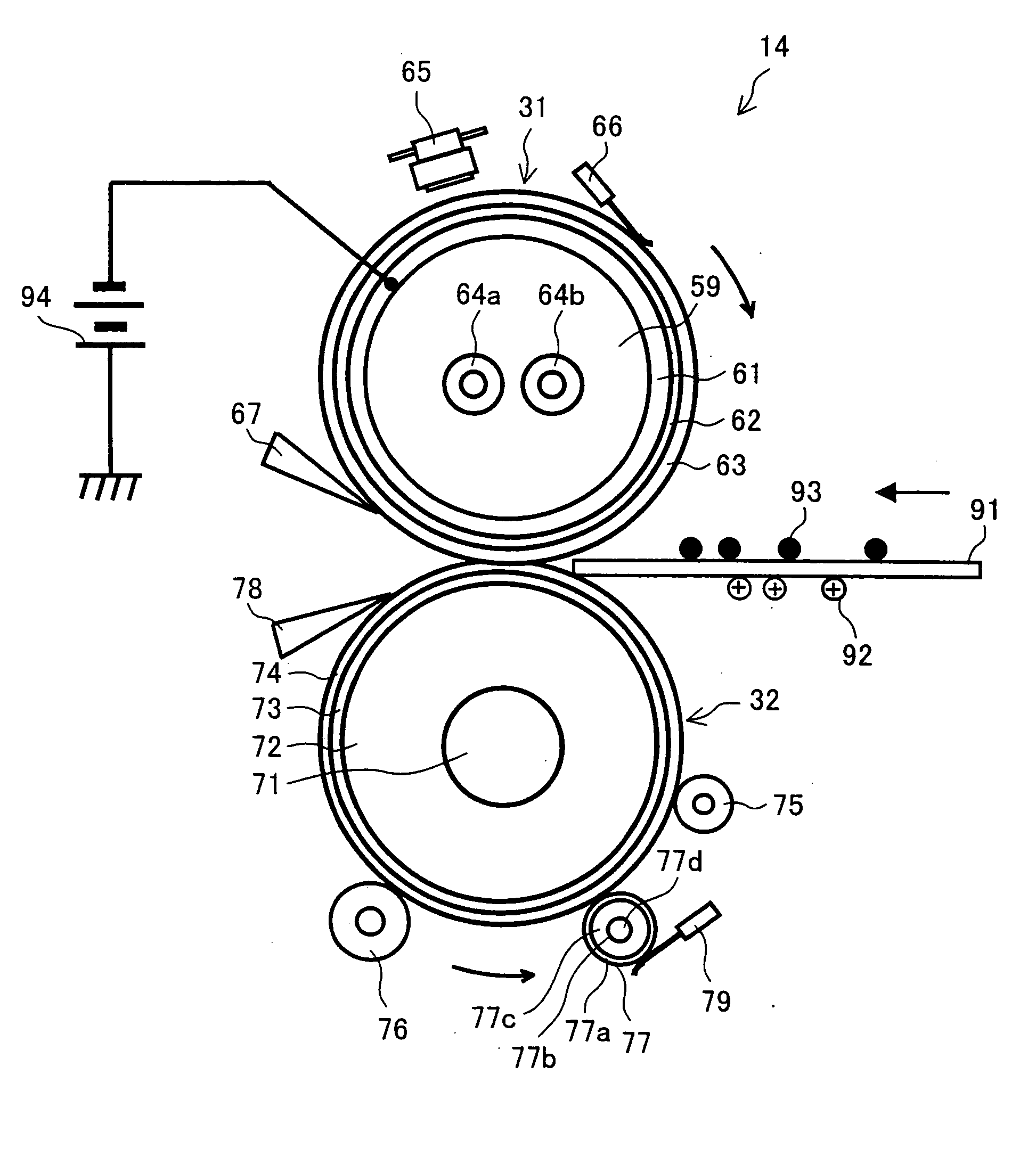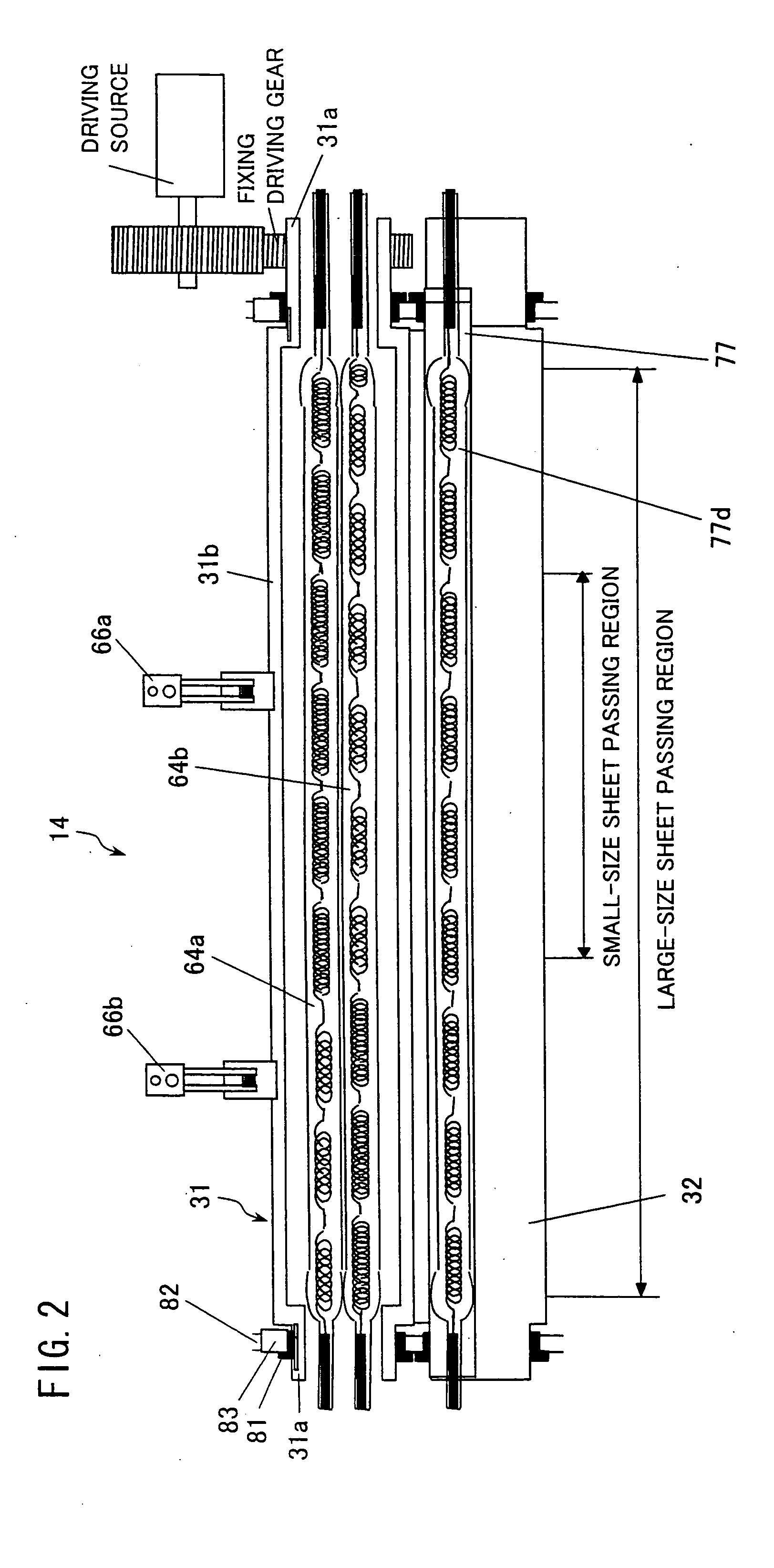Fixing device, image forming device, and manufacturing method of fixing device
a technology of fixing device and manufacturing method, which is applied in the direction of ohmic-resistance heating, shafts and bearings, instruments, etc., can solve the problems of prolonging warm-up time, requiring a longer warm-up time, and poor warm-up performance, and achieve the effect of short tim
- Summary
- Abstract
- Description
- Claims
- Application Information
AI Technical Summary
Benefits of technology
Problems solved by technology
Method used
Image
Examples
first embodiment
[0056][First Embodiment]
[0057]Referring to FIG. 1, an example of an arrangement of a fixing device of an image forming device according to the first embodiment will be described below.
[0058]FIG. 1 illustrates details of a structure of the fixing device 14. FIG. 1 is a vertical cross sectional view illustrating the fixing device 14. In the fixing device 14, a fix roller 31, which is a fix member in a roller form, is internally provided with a core 61 that is conductive (and may be a metal core), whereas a press roller 32, which is a press member, is internally provided with a core 71 that is conductive (and may be a metal core).
[0059]The fix roller 31 is formed with the core 61 as a base member, and is 40 mm in external diameter and 1.3 mm in thickness (thickness of a layer without the core). The core 61 is formed to have a predetermined external diameter and thickness by subjecting an iron-type cold rolled carbon steel tube to drawing process or the like, and then polishing the thus...
second embodiment
[0169][Second Embodiment]
[0170]Referring to FIGS. 10 and 11, another embodiment of the present invention is described below. Note that a fixing device according to the present embodiment has a basic structure same as that in the firs embodiment. Thus, explanation on the same member and feature is omitted here.
[0171]As in the first embodiment, the fixing device 121 of the present embodiment has a fix member (fix roller 97) and a press member (press roller 97), each of which is in a roller shape and has a conductive core. The fix roller 97 is provided with, for example, a core 98, an intermediate layer 62, and a releasing layer 63. The core 98 is narrowed at respective ends and has an external diameter of 40 mm.
[0172]The intermediate layer 62 and the releasing layer 63 are identical with those corresponding members in the first embodiment. The fix roller 97 of the present embodiment is different from the fix roller 31 of the first embodiment in terms of thickness (wall thickness) of t...
third embodiment
[0209][Third Embodiment]
[0210]Still another embodiment of the present invention is explained below, referring to FIG. 18. Note that the explanation on the members identical to the corresponding member in the first embodiment is omitted here.
[0211]A fixing device 114 of the present embodiment is mainly applicable to a color image forming device. In the fixing device 114, a fix belt 131 is held by a driving roller 134 and a driven roller 135. Further there provided a heating roller 77 for heating the fix belt 131. The heating roller 77 also functions as a tension roller.
[0212]In the present embodiment, the fix belt 131 in the belt-like shape is provided as the fix member. The fix belt 131 is provided with a base belt (core) 132, a releasing layer 133, and a primer (intermediate layer) 136.
[0213]The base belt 132 is 125.7 mm in circumferential length and 0.55 mm in belt thickness (thickness), and is prepared from a Ni layer of 0.5 mm in thickness. (layer thickness). Moreover, on the ba...
PUM
 Login to View More
Login to View More Abstract
Description
Claims
Application Information
 Login to View More
Login to View More - R&D
- Intellectual Property
- Life Sciences
- Materials
- Tech Scout
- Unparalleled Data Quality
- Higher Quality Content
- 60% Fewer Hallucinations
Browse by: Latest US Patents, China's latest patents, Technical Efficacy Thesaurus, Application Domain, Technology Topic, Popular Technical Reports.
© 2025 PatSnap. All rights reserved.Legal|Privacy policy|Modern Slavery Act Transparency Statement|Sitemap|About US| Contact US: help@patsnap.com



